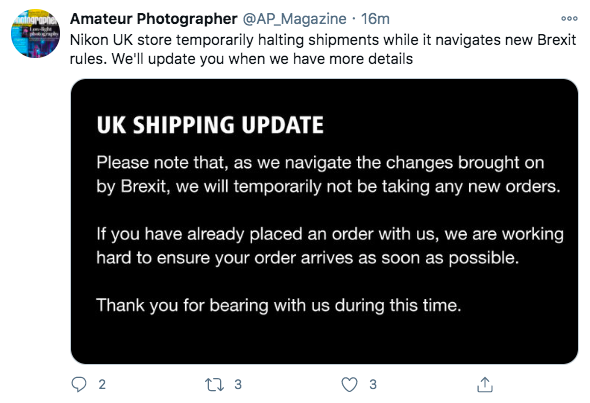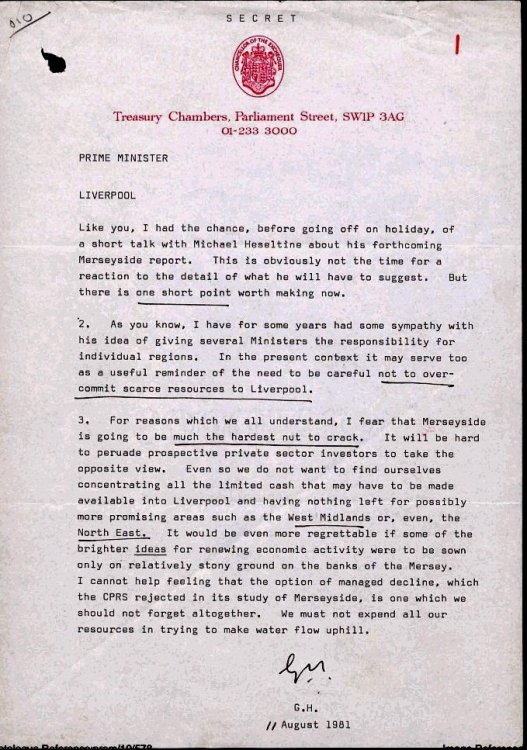-
Posts
6,092 -
Joined
-
Last visited
Content Type
Profiles
Forums
Articles
Everything posted by BTM_Pix
-
Yeah, they did a 200mm f4. They also did a 180mm f2.8 if you want to trade reach (and price) for speed.
-
Because I keep trying to sell him mine.
-
I haven't got this particular Samyang but it might be worth having a look at the Flickr pool for it to see if it takes your fancy. Samyang 16mm F2.0 ED AS UMC CS https://www.flickr.com/groups/2299572@N22/pool/ The comparison tests that I've put up on here have invariably included a Samyang variant and they always punch above their weight, particularly as a used purchase. As with most Samyang lenses, there is also the option of the cine version of it with geared focus and aperture. For an alternative, as you don't need FF, then, whilst not a prime, this Canon EF-S 10-18mm is very compact, light and is a flexible if slower option. They are also pretty cheap used and I got mine for about £130 if memory serves. https://www.flickr.com/groups/canonefs10-18mm/pool/ Gives you the option to go wider and the stabilisation comes in very handy with the P6K. As an aside, I've obviously been doing a lot of AF stuff with P6K of late with numerous different lenses and the 10-18mm is definitely one of the fastest responding and quiet of all of them.
-
There are definitely cheaper vintage lenses but the Nikkors do tend to hit that sweet spot of performance to price ratio as well if not better than anything else out there. The 105mm f2.5 is still changing hands at prices that make it one of the very best value propositions IMO. And you should buy one immediately 🙂
-
For FF or crop and what mount do you need it in ?
-
There will be more waves available for order in February. Drop an email to admin (at) cdatek (dot) com to request being added to the mailing list to get notified when they are available.
-
Yeah, thats right, typical Remoaner, you take your facts and scurry off back to join all the other liberal elites in your ivory towers of Birkenhead 😉
-
The UK parliament was famously so powerless to pass its own laws by the iron grip of the EU that it was able to pass a law to <checks notes> leave the fucking EU. You can't "Take Back Control" of something you already had control of.
-
Or as Mike Tyson put it when asked if he was concerned about his upcoming opponent's plan for the fight... *ironically, though, he then went on to lose that particular fight after his own response to being punched in the mouth was to bite off a piece of his opponent's ear..
-
Lest we forget that Farage couldn't even convince his own kids that losing their freedom of movement was a great idea. Then again, they have actually met him so are less likely to fall for his bullshit. Quite the volte face too for such a devoted Spitfire shagger as him to say in that same article that Britain lost the Second World War. Wonder if his ilk amongst the England team's fans will now have to modify the lyrics to their favourite chant to German fans to "One World War and one World Cup doodah doodah" now then ?
-
In fairness to Remain, the basis for their position was the established rules that apply to 3rd countries with regard to their relationship with the EU and contrast that with the status quo of what our current membership of the union meant to the UK. Those rules were and remain facts for 3rd countries whether its to do with trade, immigration or other regulations and have always been easily verified. In contrast, the Leave campaign was largely based more on feelings than it was facts. Which is fine, I suppose, as we're all human so feelings matter, but unfortunately trade agreements and established rules for 3rd countries can't be overcome by three word nebulous slogans such as "Take Back Control". So from 1st. January 2021, the only thing that has and will matter is the factual reality of being a 3rd country to our nearest major trading partner. The UK could've negotiated to leave the EU but still be part of the single market, like Norway for example, and this option was actually stated as an intention by this journalist below shortly after the referendum. I mean, I know its just the statement of a journalist who had previously been sacked by another newspaper for lying and I'm guessing he's probably faded into obscurity since but, still, he was one of the leaders of the Vote Leave campaign so that intention does seem at odds with everything that has happened since and what they have attempted to negotiate. The Government's repeated bleatings that they would seek an "Australian style deal" was just an absolute nonsense as, with Australia not actually having a deal with the EU, it was actually code for no deal. It was often stated that the Government might as well be saying "Afghanistan style deal" or "Mongolian style deal" but even that wasn't accurate as both of those countries have more favourable arrangements with the EU than Australia. Its happened though so we are where we are with the agreement they eventually did negotiate and have to deal with it. One major obstacle is the lack of preparation time for it whilst the Government ran the clock down and the lack of experience to deal with the practicalities. Prior to the single market, when we exported gear either for sale or for touring, it was the same level of pain in terms of documentation and shipping/customs agents whether we were sending it to Munich or Miami. After the single market, sending gear to Munich suddenly became indivisible to sending it to Middlesbrough and UK businesses have had almost thirty years of trading that way. Not only does it mean that new processes like JIT manufacturing have evolved to benefit from it but there are an enormous amount of companies who have never had to deal with all but the scantest import/export procedures for their goods or supply lines. The procedures involved now to send something to Munich requires the same specialist skills that were last needed almost three decades ago and they just aren't there. When the mitigation work for the Millennium Bug was happening, there were a lot of systems that were created using COBOL that necessitated a lot of retired programmers being brought back to earn serious cash as those skills had left the workforce as they hadn't been required any more. I think it might be the same story for a lot of UK pensioners who had the experience of how to navigate the hoops to jump through to get machinery from London to Paris in the 80s ! The impact of being a 3rd party trying to get goods into the EU across its land borders is well known and isn't Project Fear, its just the reality of it. This site is used by transportation companies to show real time info on waiting times at borders : https://www.transporeon.com/en/expertise/corona-update/real-time-overview-international-traffic/ If you look at Poland and compare the waiting times at its border with its EU neighbours such as Germany, Slovakia and the Czech Republic with its border with Belarus then the difference is clear. What is also clear from that are the delays at the channel ports of the UK. The mitigation of the UK authorities in using holding areas away from the ports themselves means that the expected media coverage of endless queues at Dover hasn't happened but oddly enough that actually demonstrates something even more concerning. Namely that the amount of traffic is down as companies can't get the formalities sorted but also because EU transport companies are now reluctant to send trucks to UK as the delays both way are costing them too much money to make it worthwhile. Importing and exporting goods is one of those things that a majority or even a sizeable minority of people don't have any direct experience of but it is something that because of the supply chain processes that have built up since we joined the single market we are all impacted by, whether its for buying a book off Amazon or a lettuce from Tesco. Disruption to those supply chains, by which I mean delays rather than flat out stoppages, will eventually trickle down to everyone but, like anything, its only when it gets personal that it hits home ! Nikon UK have today had to act in this regard The salient point in this is not if they get it resolved or even necessarily how long it takes them but in terms of how they resolve it. When you had frictionless trade and now you've had a lot of friction put back in then the only way to remove it will likely to be to polish it away with money. If you can't get your cameras imported efficiently or without variable delays because of admin then you have to hire dedicated staff. If you can't get them brought in by ship/lorry due to the penalty cost of shippers having to deal with the customs procedures then you'll have to fly them in. If you can't get reliable lead times for re-supply then you'll have to hold more stock to mitigate it. All of that costs money and its inevitable that it will find its way to being added to the retail price. Even when Covid goes away, when all the companies have caught up with training their admin staff to deal with the processes, when the government have tarmacced over the rest of Kent to accommodate the lorries, we will still not have frictionless trade because no 3rd country can have frictionless trade with the EU. So it means more cost to export and more cost to import. The EU aren't punishing us with some new rules, we punished ourselves by not understanding them when we are a part of it. Still, those fish are much happier now so there's that.
-
Mmmm....I could use either of the Ursas they have as I'll just be testing code but for the extra €39 I might as well go large and rent the 12K ! Thanks for your help.
-
I'm after renting an Ursa Mini Pro or a G2, do you have any recommendations where I can rent one in Madrid post plague ?
-
That actually looks really interesting. Look forward to hearing your thoughts about it if you get one.
-
My Uncle lived in a flat on Smithdown and, yeah, the difference in how Parly looked when we were driving up it on the bus going to visit him pre and post riot was marginal 🙂 . The front page of today's FT shows the wholly anticipated direction of travel now that this government is free of those pesky EU rules. The painful economic recovery from COVID and "re-adjustment" to Brexit trading conditions will give convenient cover for the unscrupulous to exploit any sort of removal of protections. And this is only week two.
-
What ? Thats not scorn and derision, its the absolute reality of the situation when this party has an 80 seat majority. Lets not forget that in September 2020, they used that majority to pass a bill that would allow them to break international law. And then used that majority to vote down an amendment to the bill that would have required "ministers to respect the rule of law and uphold the independence of the courts". Considering all of this was set in motion while still a member of the EU, how did any of that require the UK to leave the largest trading bloc in the world? More to the point, how will the uncompleted elements fare with even the government's best case scenario of a 5% reduction in GDP with the deal that they negotiated compared to the one we had ? How are the airport and the port going to be impacted by the UK leaving the bloc too? Hostile environment in the UK, more restrictions on travel from the UK to the EU and the painful import/export process of being a 3rd country to its nearest substantial market is a concern, I would've thought. I'm guessing you're from Teeside, so more of the £180 million pounds that region has had in funding from the EU in the past six years would certainly have come in handy over the next years to support these and other initiatives. Whilst it is great news for your area to have had the current Conservative chancellor making the trip up there with his cheque book, a previous Conservative chancellor had a cunning plan for my city when they decided that there was no point trying to win us round to "their" way of thinking and hence not worth their effort and called for its "managed decline". It was the EU investment that provided the money for Liverpool to recover, not central Government, and that is why we voted to Remain and continue to reject the Conservatives. I honestly hope it works out for you and they don't subsequently shit on your region but, unfortunately, that 80 seat majority they were handed means we don't even have a two party system to oppose them even if they do. Incidentally, we also have a Metro Mayor of our Region but it hasn't stopped the funding cuts from central government, both pre and post Covid-19, so devolution is not a panacea. It just passes the buck of which library or meals on wheels service to close to someone else other than the government. Cheers and good luck.
-
Sadly, we are all going to get what they voted for too. If there was ever any doubt about the contempt and disregard for the consequences of their actions that this Conservative government has then Jacob Rees Mogg's response to being scrutinised about the piles of rotting fish that are being amassed on quaysides as supply routes to the EU collapse should close the book on those doubts once and for all. How any working class person could ever have looked at him and thought "Yep, he's my guy, he has my interests at heart, there's no way he is pursuing Brexit for his own ends" is absolutely unbelievable. Particularly when his Dad literally wrote the book on the opportunities that chaos can create. His own self serving hypocrisy should've been a big warning sign as well
-
The bottom line is that if someone voted to leave in 2016 and then voted Conservative in 2019 to "get Brexit done" then that person now better hope and pray that their domestic policy requirements align precisely with those of the Conservative party. Because from here until 2024, that person is going to get exactly what the Conservative party determine that they are going to get and no more. And with the 80 seat majority that they helped deliver for them, they have ensured that it will be unopposed. If anyone is in any doubt about how that might work out, then a quick glimpse of their voting records should prove enlightening.
-
This poll was, of course, taken, after watching his performance in office for four years so not indicative of any correlation between Brexit voters feelings about him in 2016 when obviously he wasn't actually in office yet. In any case, neither UKIP nor the Brexit party won a single constituency in the UK general elections either, so using UK constituency voting intention is not really even a useful indicator of a link between Brexit and, well, Brexit. Particularly when you consider that Nigel Farage, the undisputed high priest of Brexit, has never been able to win a parliamentary seat in his whole career despite seven attempts over a period of two decades. Where you will find a link between Brexit and UK voting is, of course, is when you look at the election record of UKIP etc in the European Elections where due to those utilising proportional representation rather than first past the post, the number of votes cast as a whole is reflected in the number of seats awarded. So UKIP/Brexit Party etc can get fairer representation in the parliament that they were demonising than they can in their own parliament. Which is all a bit awkward really isn't it ? It also blows a big hole in the lack of "sovereignty" as well as surely the EU would have insisted on the UK adopting proportional representation too ? So, of course, the UK has always had sufficient "sovereignty" to determine its own election processes irrespective of being in the EU or not and could also have chosen to establish this fairer method of distribution of seats in it own parliament. This would have afforded the supporters of the UKIP/Brexit Party etc a genuine stake in shaping domestic issues. But of course, the reason that proportional representation will always be voted down in the UK can be found in the result of the 2019 general election. The Conservatives got 43.6% of the votes cast in the country and were rewarded with 364 seats (56% of the total seats). Whereas between them, the Labour & LibDems got 43.7% and received only 214 seats (32.92% of the total seats). It was framed as a Brexit election but with the way the constituency boundaries have been re-drawn over the years it delivered an 80 seat majority that means the Conservative party can now basically rule by decree. Under proportional representation, they wouldn't have had a working majority even with the support of parties allied to Brexit such as UKIP etc. So the bigger and actually more damaging impact of Brexit isn't just Brexit itself, as damaging as it is to wilfully impose economic sanctions on yourself, but that it has now delivered at least five years of unopposed space in which the Conservative government can impose policies that will be no friend to the working class. There were many legitimate grievances from working class people that voted to Leave in 2016. Unfortunately, they were aimed at the wrong parliament.
-
Providing Fujifilm don't completely cripple it then I'll be having a fire sale to get the upcoming GFX100S. If it is too compromised then I'll be having an inferno sale to buy a used version of the original GFX100. And then switch the internet off.
-
I wish! Should have splurged out on one of the knockoffs years ago? But would like to read more reviews about them. Careful, I seem to remember the last time EasyRigs were brought up on here we ended up with about ten pages of a forum version of this ....
-
Well, in the UK, as you can see from this ad, they were as equally associated with tobacco as they were with booze. I don't know whether it was just a random selection that determined if they turned up to rescue you with either brandy or tobacco or whether it was a more bespoke service depending on your needs like a forerunner (or pawrunner in this case) of Ubereats or Deliveroo.
-

Review of the year, 2020 - THE YEAR FROM HELL!!
BTM_Pix replied to Andrew - EOSHD's topic in Cameras
-

Pro camcorder ergonomics - why are they so rubbish?
BTM_Pix replied to Andrew - EOSHD's topic in Cameras
I think Renault did show a concept version based on it a while back. Meanwhile, this guy took matters into his own hands. -
These two delivering the vaccines in those little barrels would be the heartwarming finale that we all need for the disaster movie that has been 2020.













